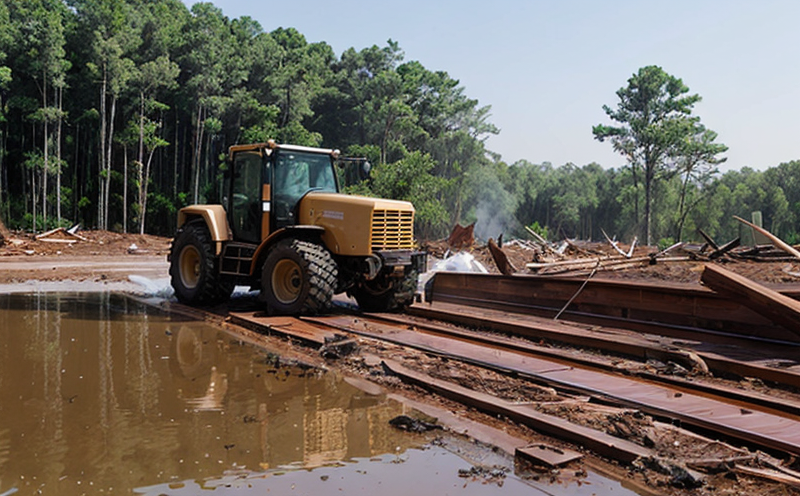EN 50102 Mechanical Impact Environmental Testing of Outdoor Lighting
The European standard EN 50102 specifies mechanical impact environmental testing for outdoor lighting equipment. This testing is crucial to ensure that the devices can withstand the harsh conditions they are likely to encounter in real-world applications, such as being struck by vehicles or subjected to wind and rain. The standard aims to protect not only the integrity of the lighting but also public safety.
The tests outlined in EN 50102 are designed to simulate various types of mechanical impacts that outdoor lighting fixtures might experience during their operational lifecycle. These include impacts from falling debris, vehicular collisions, and pedestrian strikes. The standard covers both static and dynamic loads and specifies the test methods for determining impact resistance.
Static load tests assess how a fixture holds up under sustained pressure or weight, while dynamic load tests evaluate its performance when subjected to sudden changes in force. For instance, dynamic load testing might involve simulating a car hitting a street light post at low speed. The equipment used for these tests includes specialized impact testers that can replicate real-world scenarios accurately.
Compliance with EN 50102 is mandatory for manufacturers of outdoor lighting systems intended for use in European markets. This ensures that the products meet stringent safety and performance standards, thereby protecting both users and pedestrians from potential hazards. The testing process involves several stages:
- Preparation: Careful preparation of the specimen to ensure it is representative of the actual product.
- Testing: Conducting mechanical impact tests using appropriate instruments as specified in the standard.
- Data Collection: Recording all relevant data from each test run, including force applied and displacement measured.
- Evaluation: Analyzing collected data against predefined acceptance criteria to determine compliance with EN 50102 requirements.
The acceptance criteria for mechanical impact tests are based on the expected lifespan of the lighting fixture and its intended environment. For example, fixtures in urban areas may have different standards than those used in rural settings due to varying levels of vehicular traffic and pedestrian activity.
Understanding the nuances of EN 50102 helps manufacturers design products that not only meet regulatory requirements but also enhance overall product quality and reliability. Compliance with this standard enhances brand reputation by demonstrating commitment to safety and excellence, which can be a significant advantage in competitive markets.
Industry Applications
- Urban Infrastructure: Ensuring that streetlights and traffic signals are robust enough to withstand vehicular impacts.
- Roadside Lighting: Providing fixtures capable of withstanding environmental stresses caused by weather conditions and occasional accidents.
- Rural Installations: Guaranteeing the durability of lighting in less trafficked areas, where impact from debris or animals might be more frequent.
The application of EN 50102 extends beyond mere compliance with regulations; it also supports broader industry goals such as enhancing public safety and reducing maintenance costs. By ensuring that outdoor lighting fixtures are robust enough to handle mechanical impacts, manufacturers contribute to safer urban and rural environments. This not only reduces the likelihood of accidents but also minimizes downtime associated with frequent repairs or replacements.
From a business perspective, compliance with EN 50102 can open up new markets within Europe and beyond. Companies that demonstrate their commitment to quality through adherence to this standard are often favored by municipalities and other public authorities responsible for infrastructure maintenance. Additionally, the testing process itself serves as an excellent quality control measure, helping manufacturers identify potential weaknesses in their designs early on.
Environmental and Sustainability Contributions
The implementation of EN 50102 Mechanical Impact Testing plays a pivotal role in promoting environmental sustainability by reducing waste associated with premature failure of outdoor lighting fixtures. By ensuring that these devices are capable of enduring mechanical impacts, the standard contributes to longer-lasting products, which ultimately lead to reduced energy consumption and operational costs over their lifecycles.
Longevity is just one aspect; another critical contribution lies in minimizing material usage during manufacturing processes. Manufacturers who adhere strictly to EN 50102 specifications tend to optimize design elements that enhance durability without increasing unnecessary weight or bulk, thus conserving resources throughout the production cycle. Furthermore, robust fixtures contribute positively towards reducing energy consumption since they do not need frequent replacement due to accidental damage.
Moreover, compliance with EN 50102 supports broader sustainability initiatives by fostering innovation within the lighting industry. As manufacturers strive to meet stringent mechanical impact testing standards, there is increased focus on developing advanced materials and technologies that improve both performance and environmental friendliness. This shift towards more sustainable practices aligns well with global trends towards greener manufacturing processes.
Competitive Advantage and Market Impact
- Increased Customer Trust: Demonstrating compliance with recognized international standards like EN 50102 builds trust among consumers and potential clients, enhancing brand loyalty.
- Better Product Quality: Adherence to rigorous testing protocols results in higher-quality products that perform consistently under diverse conditions.
- Premium Pricing Justification: Meeting or exceeding required standards allows manufacturers to justify premium pricing for their offerings based on superior product performance and reliability.
The impact of adhering to EN 50102 extends beyond individual companies; it also influences the broader market by setting higher industry-wide standards. As more competitors adopt these practices, overall market quality improves, leading to increased demand for compliant products. This creates opportunities for innovative solutions that push boundaries in terms of both functionality and sustainability.
For businesses operating within regulated markets like Europe, compliance with EN 50102 is essential for staying competitive. It provides a clear pathway for achieving regulatory requirements while simultaneously enhancing product quality and marketability. In essence, it serves as a key differentiator that can significantly influence customer choice and market positioning.





